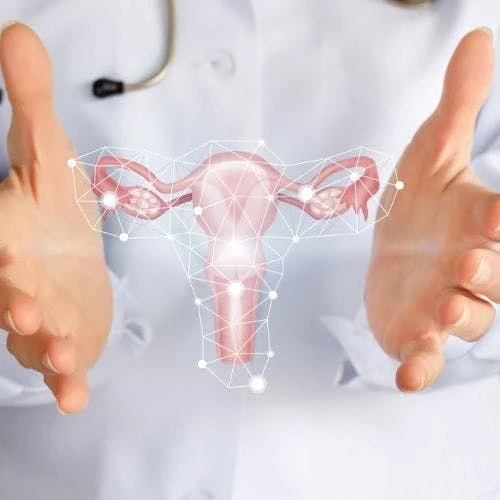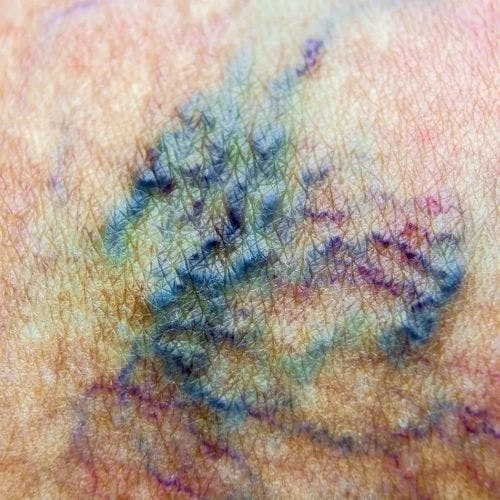Adenomyosis
WHAT IS ADENOMYOSIS?
Adenomyosis is a benign condition in which tissue from the endometrial layer, or the innermost layer of
the uterus, grows into a layer of muscle in the uterus. The uterus is a muscular organ with three layers:
the endometrium (inner lining), the myometrium (middle muscular layer) and serosa (outer smooth
layer that covers the uterus) [1]. When the endometrial tissue grows into the muscle, it causes the
uterus to enlarge. It is unknown what causes this condition; however, the most likely theory is that small
areas of trauma and inflammation in the myometrium causes the endometrium to grow into the
muscular layer [2]. Adenomyosis can cause painful and distressing symptoms; however, it is a benign
condition that does not cause or increase the risk of cancer [2].
ADENOMYOSIS SYMPTOMS
Painful periods can be caused by several medical conditions, and adenomyosis often will present by
patients complaining of painful menstruation; however, some patients who have adenomyosis may not
experience any symptoms at all. The most common symptoms of adenomyosis are usually painful
and/or heavy bleeding during periods, chronic pelvic pain and irregular bleeding from the uterus.
Abnormal uterine bleeding is when bleeding from the uterus happens at irregular times (not associated
with periods) or there is bleeding for prolonged periods of time. Infertility may occur; however, the
association is still unclear [4].
ADENOMYOSIS DIAGNOSIS
The first step of diagnosing adenomyosis is to collect information on symptoms as well as past
medical and surgical history. When a physician examines the uterus by gently palpating the pelvic area,
the uterus typically feels soft and is symmetrical. Irregularities on the exam may include an abnormally
large uterus, firmness, a palpable mass or even tenderness felt by the patient during the exam. If
adenomyosis is suspected, a transvaginal ultrasound is then recommended to evaluate and diagnose
adenomyosis.
ADENOMYOSIS TREATMENT
There are multiple treatment options to help with symptoms. Nonsteroidal anti-inflammatory drugs
(NSAIDS) can help improve pain and inflammation, and these include common over-the-counter
medications such as ibuprofen. Other medication options include hormone therapy or oral
contraceptives. Specific hormones can decrease estrogen in the body, which is important since estrogen
causes the endometrial layer to grow. These medications can limit the overgrowth of the endometrial
layer of the uterus. The combined oral contraceptive pill is a combination of progestin and estrogen
which works by decreasing ovulation and estrogen production within the body, working similarly to
decrease endometrial growth [5].
ADENOMYOSIS HYSTERECTOMY
Surgical treatment can include a hysterectomy, or removal of the uterus, which is usually
done in patients with severe symptoms or in patients who do not wish to become pregnant.
Another method, known as uterine artery embolization, uses a procedure to block
uterine blood vessels in order to stop blood flow to this area. This will cause the tissue to die and
prevent it from overgrowing. In patients who desire future pregnancy, it is possible to remove either the
focal adenomyosis or diffuse area around the uterine wall [3] while still keeping the uterus intact.
ADENOMYOSIS vs FIBROIDS
Fibroids, also known as uterine leiomyomas, are very common benign growths of smooth muscle cells of
the muscular layer of the uterus (myometrium). Between 40% and 60% of women can develop fibroids,
though only 20% to 50% of patients with fibroids have symptoms [2,6]. Symptoms are similar to
adenomyosis, with the most common being heavy or abnormal bleeding. Infertility is possible but rare
(about 1% to 3% of infertility cases are due to fibroids) [5]. On pelvic exam, the uterus will be enlarged in
various locations and small, smooth masses can be felt. This is different from adenomyosis, where the
entire uterus is enlarged. After an exam by your physician, fibroids are confirmed by a diagnostic
Related: Is My Vagina Normal? Plus A Female Anatomy Chart
transvaginal ultrasound. Treatment is similar to the treatment of adenomyosis with hormonal options.
For women desiring future pregnancy, myomectomies (surgical removal of the fibroid only, while
keeping the uterus intact) can be performed.
ADENOMYOSIS vs ENDOMETRIOSIS
Endometriosis is a condition in which the inner lining (endometrium) grows outside the uterus, as
opposed to adenomyosis where the endometrium grows into the muscular layer in the uterus only and
does not extend past this area. Tissue can grow on fallopian tubes, ovaries, bowel, appendix, bladder
and other structures. It can cause painful periods, pain during intercourse, uncomfortable bowel
movements and even infertility. Infertility is more common with endometriosis than with fibroids or
adenomyosis. Pelvic examination by a physician may demonstrate tenderness in the pelvic region, pain
with movement of the uterus, or even an immobile uterus. However, many patients may not have any
abnormal findings. Diagnosis is usually made with laparoscopy, a procedure where a small camera is
placed inside the abdomen to look for endometrial tissue at internal structures such as the uterus,
fallopian tubes, ovaries and bowel. Treatment is similar to adenomyosis with anti-inflammatory
medication to help with pain and hormonal methods to suppress tissue growth. Surgical treatment
includes removing or destroying the abnormal tissue. As with adenomyosis, if a patient does not desire
to have future pregnancy or has severe symptoms, surgery to remove the uterus, fallopian tubes, and
ovaries may be performed [2,5,7].
DO I HAVE ADENOMYOSIS?
Adenomyosis, uterine fibroids and endometriosis are common conditions that can cause no symptoms
at all or become severe enough to cause significant pain and distress. This can depend on various factors
such as age, ethnicity and location/extent of the abnormal tissue. While moderate to severe symptoms
can be concerning for patients, they are typically benign conditions. However, there are several medical
and surgical treatment options available to help with these conditions. If you think you are experiencing
symptoms of adenomyosis, please consult your physician for a treatment plan that is right for you.
AUTHORS: DR. ERIKA ARAGONA, SRIJAA KANNAN
Resources:
1. Anatomy of the uterus. (n.d.). Retrieved March 26, 2021, from
uterus#:~:text=The%20uterus%20has%203%20layers,Myometrium
2. Dougherty M.P., & DeCherney A.H. (2019). Benign disorders of the uterine
corpus. DeCherney A.H., & Nathan L, & Laufer N, & Roman A.S.(Eds.), CURRENT
Diagnosis & Treatment: Obstetrics & Gynecology, 12e. McGraw-
Hill. https://accessmedicine-mhmedical-
com.proxy.unthsc.edu/content.aspx?bookid=2559&sectionid=206964644
3. Stewart, Elizabeth et al. (2021). Uterine adenomyosis. UpToDate. Accessed on March 26,
2021.
4. Harada, T., Khine, Y. M., Kaponis, A., Nikellis, T., Decavalas, G., & Taniguchi, F. (2016).
The Impact of Adenomyosis on Women's Fertility. Obstetrical & gynecological
survey, 71(9), 557–568. https://doi.org/10.1097/OGX.0000000000000346
5. Benign uterine pathology. Hoffman B.L., & Schorge J.O., & Halvorson L.M., & Hamid
C.A.,
& Corton M.M., & Schaffer J.I.(Eds.), (2020). Williams Gynecology, 4e. McGraw-
Hill. https://accessmedicine-mhmedical-
com.proxy.unthsc.edu/content.aspx?bookid=2658&sectionid=218095333
6. Stewart, Elizabeth et al (2021). Uterine fibroids (leiomyomas): Epidemiology, clinical
features, diagnosis, and natural history. UpToDate. Accessed on March 26, 2021.
7. Schenken, Robert, Barbieri, Robert, Eckler, Kristen (2021). UpToDate: Endometriosis:
pathogenesis, clinical features, and diagnosis. UpToDate. Accessed on March 26, 2021.
We discuss products we think are useful to people. If you buy something through our links, we may earn a commission. Remember to check with your personal physician to see if a product recommended is right for you.








